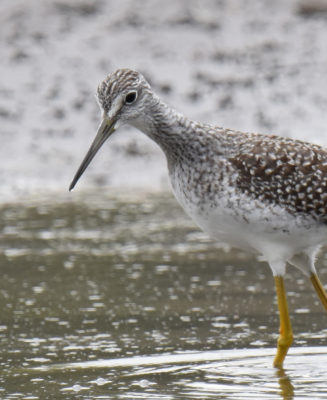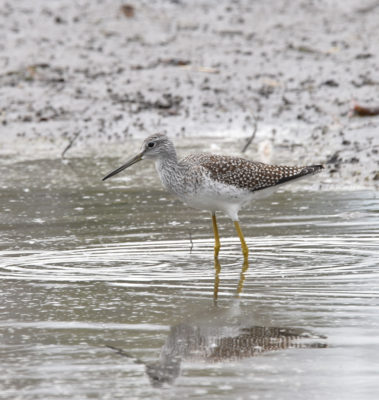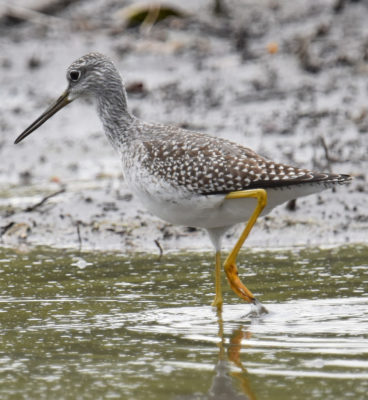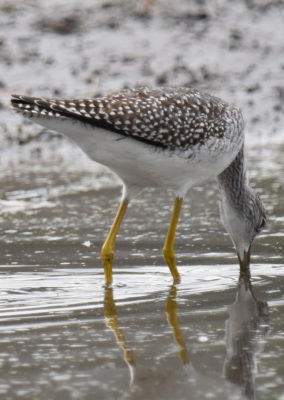This first week in October has offered some quite warm, though cloudy days. Despite my suspicions that the skies might open at any minute, I took a chance and visited the Rattray Marsh in Mississauga. There has been a large mud flat at the mouth of the lagoon which I wanted to check for passing sandpipers and Rusty Blackbirds, both of which I’ve seen in that area on other early autumn days.
Look Who Just Flew Into View
There wasn’t much unusual to see when I first reached the outlet of the lagoon where it empties into Lake Ontario. So I settled down and waited a while. A Yellow-Rumped Warbler flew by. I noticed a Great Blue Heron was slowly stalking through the waters on the far side of the “keep out the carp” fence. A trio of Hooded Mergansers were feeding rather frenziedly on something they had found on the other side of that fence—and they were following it, swimming heads immersed up into the lagoon.
Then with a series of interesting call notes, a large bird flew in and landed on the mud flat quite close to where I was watching. It was a Yellowlegs.
Is This a Greater or a Lesser Yellowlegs?
The bright yellow legs and overall shape and colour make it fairly easy to decide the bird is one of the two types of Yellowlegs. But which type?
The size of the bird, especially compared to a nearby Killdeer, was quite obvious. The bill was also noticeably long. It’s harder to see that in my photos—they were taken with a 600 mm zoom lens which tends to shorten the appearance of the beak. A few leftover dots on the bird’s flanks behind the legs are inconclusive but suggest it’s a Greater Yellowlegs. The combination of all of those features leads me to risk saying it was a Greater Yellowlegs. (It was reassuring to see on eBird that other birders had also reported a Greater Yellowlegs from the marsh that day.)
A Lesser Yellowlegs is close to the size of a Killdeer, has a shorter bill, and in breeding plumage often doesn’t have dark bars or dots behind the legs near the tail. Lesser Yellowlegs are often seen at the Rattray on migration, too.
This Yellowlegs moved quickly, hunting along the edge of the mudflat till it reached the western carp fence, which it winged over, then kept walking further away.

Yellowlegs seem to look for food not just probe around in the mud.
I was pleased to see this bird. Once it was out of sight, though, I also watched two Kingfishers calling and flying around the lagoon. Several small groups of Mallards came and went. A Turkey Vulture soared over head. And the small family of Mute Swans (one parent and 2 greyer young) appeared then drifted back into the hidden waters. And two Monarchs sailed past, flying parallel to the Lake.
Perhaps best of all, the showers held off till I finished my explorations. I hope the weather cooperates the next time I go out—and another co operative bird would be appreciated too!
Related Reading
- Semi-Palmated Plovers Have Toe Webs
- Spotting Spotted Sandpipers
- Relaxing Beside the River
- Killdeer Have an Odd Display
Join In
Have you ever had to decide whether you’re watching a Greater or a Lesser Yellowlegs? What about picking out a White-rumped Sandpiper in a flock of Peeps? Please share your shorebird story with a comment.



